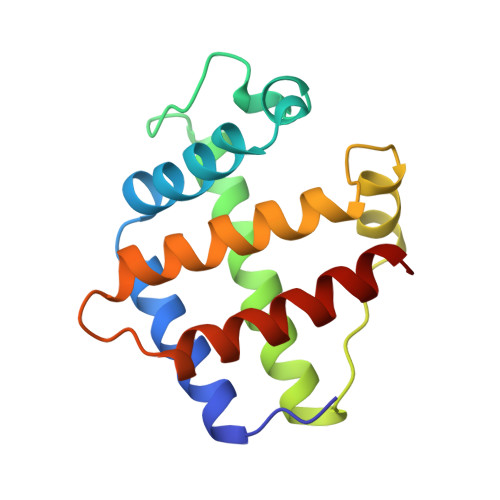Characterization of recombinant soybean leghemoglobin a and apolar distal histidine mutants.
Hargrove, M.S., Barry, J.K., Brucker, E.A., Berry, M.B., Phillips Jr., G.N., Olson, J.S., Arredondo-Peter, R., Dean, J.M., Klucas, R.V., Sarath, G.(1997) J Mol Biol 266: 1032-1042
- PubMed: 9086279
- DOI: https://doi.org/10.1006/jmbi.1996.0833
- Primary Citation of Related Structures:
1BIN - PubMed Abstract:
The cDNA for soybean leghemoglobin a (Lba) was cloned from a root nodule cDNA library and expressed in Escherichia coli. The crystal structure of the ferric acetate complex of recombinant wild-type Lba was determined at a resolution of 2.2 A. Rate constants for O2, CO and NO binding to recombinant Lba are identical with those of native soybean Lba. Rate constants for hemin dissociation and auto-oxidation of wild-type Lba were compared with those of sperm whale myoglobin. At 37 degrees C and pH 7, soybean Lba is much less stable than sperm whale myoglobin due both to a fourfold higher rate of auto-oxidation and to a approximately 600-fold lower affinity for hemin. The role of His61(E7) in regulating oxygen binding was examined by site-directed mutagenesis. Replacement of His(E7) with Ala, Val or Leu causes little change in the equilibrium constant for O2 binding to soybean Lba, whereas the same mutations in sperm whale myoglobin cause 50 to 100-fold decreases in K(O2). These results show that, at neutral pH, hydrogen bonding with His(E7) is much less important in regulating O2 binding to the soybean protein. The His(E7) to Phe mutation does cause a significant decrease in K(O2) for Lba, apparently due to steric hindrance of the bound ligand. The rate constants for O2 dissociation from wild-type and native Lba decrease significantly with decreasing pH. In contrast, the O2 dissociation rate constants for mutants with apolar E7 residues are independent of pH, suggesting that hydrogen bonding to the distal histidine residue in the native protein is enhanced under acid conditions. All of these results support the hypothesis that the high affinity of Lba for oxygen and other ligands is determined primarily by enhanced accessibility and reactivity of the heme group.
Organizational Affiliation:
Department of Biochemistry and Cell Biology, Rice University, Houston, TX 77005-1892, USA.

















